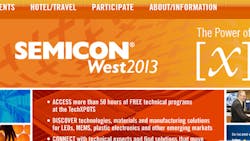Semiconductor makers return manufacturing to U. S.
|
Resources Semicon West 2013, www.semiconwest.org |
Here’s a bit of good news for semiconductor-manufacturing OEMS from Tom Morrow, vice president of SEMI, the overarching organization for the semiconductor industry: “We anticipate that next year will be up in capital-equipment spending for semiconductor-manufacturing equipment by about 20%, with increasing investments in North America.”
No, that’s not a misprint. Long known for making big bets on Asian fabrication facilities, the semiconductor industry is starting to put more emphasis on manufacturing capabilities in the U. S. Morrow says the reasons relate to the still-prodigious amount of U. S.-based infrastructure, the involvement of industry alliances such as Sematech and the Global 450 Consortium (G450C), and upcoming technical challenges in semiconductor manufacturing. “The risks are getting higher on the cutting edge of technology. Those are factors that have led manufacturers to say they’d rather experiment here than in Asia,” Morrow explains.
Specifically, SEMI sees semiconductor-manufacturing equipment sales hitting $17 billion worldwide this year with a lot of growth next year because of new spending on 450-mm pilot lines. Spending in the U. S. is expected to account for 22% of all worldwide semiconductor capital-equipment spending, up from 15% a few years ago.
Several technical challenges are forcing equipment makers to ramp up their R&D. Besides the platform engineering associated with 450-mm wafer manufacturing, “The industry is struggling with getting productivity in extreme UV lithography,” says Morrow. “The introduction of new nonplanar semiconductor architectures is requiring a lot of reengineering of chamber performance parameters. This development has also led to the introduction of new materials that make R&D and testing activities more complex,” he says.
Another challenging area is associated with 3D integrated circuits. “The industry senses that Moore’s Law is slowing down and that cost reductions will have to come from areas besides finer lithography,” Morrow says. “The stacking of chips to save space, particularly for mobile-phone applications, is creating a lot of opportunity for innovation.”
Two formerly hot areas that won’t be seeing much action are LEDs and solar cells. “The enthusiasm for both of these areas was a market bubble,” says Morrow. “Overinvestment in China has led to rapid price declines and consolidation. People are not investing in new LED fabs. Capacity probably has peaked and won’t expand significantly beyond that of today. Equipment spending on solar may not recover until late 2014.”
These issues and more will be topics of discussion at the upcoming Semicon West 2013 exposition on July 9-11 in San Francisco. The event will play host to 560+ exhibitors and over 50 hr of technical programs covering 450-mm technology, EUV, 3D-ICs, technology roadmaps, and more.
